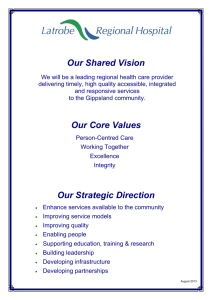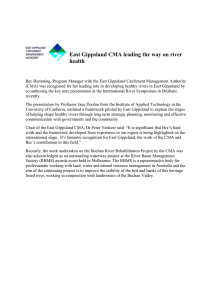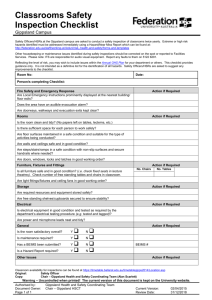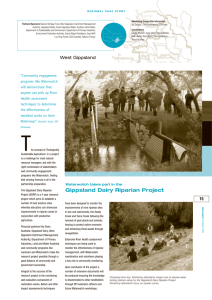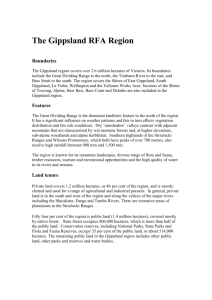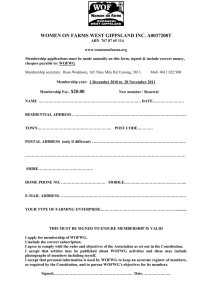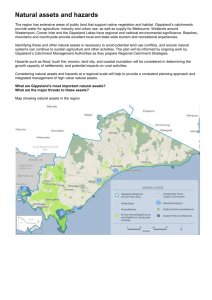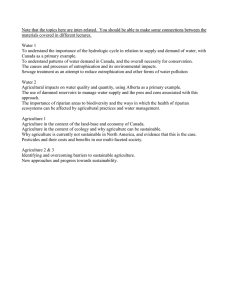Riparian Action Plan for East Gippsland
advertisement
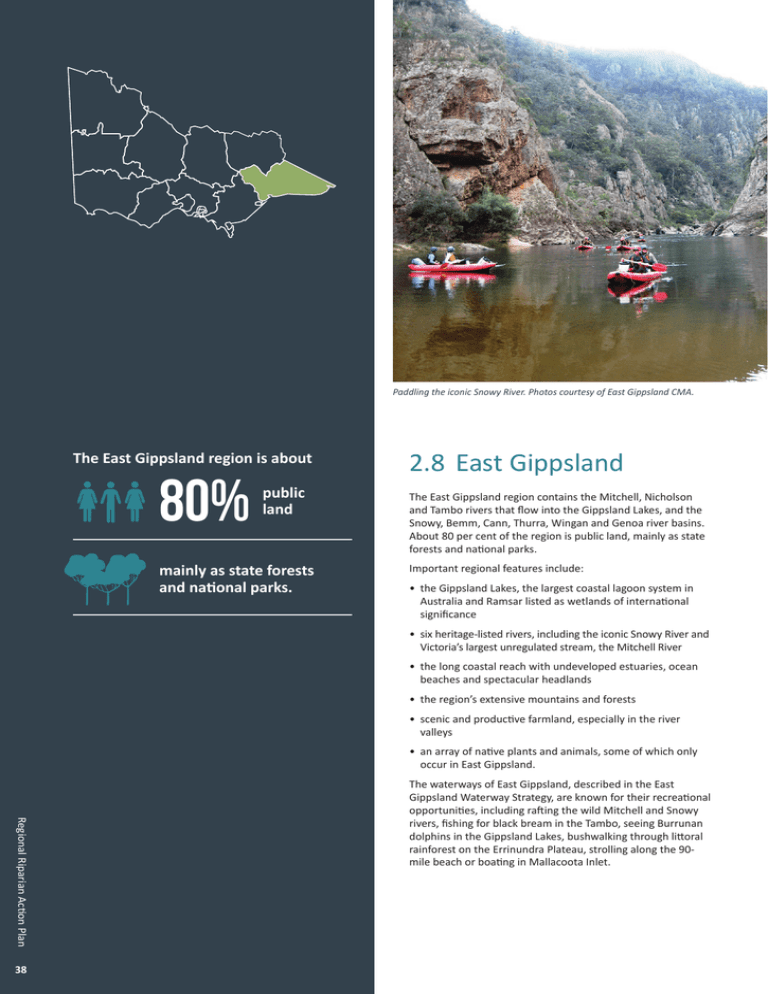
Paddling the iconic Snowy River. Photos courtesy of East Gippsland CMA. The East Gippsland region is about 80% public land mainly as state forests and national parks. 2.8 East Gippsland The East Gippsland region contains the Mitchell, Nicholson and Tambo rivers that flow into the Gippsland Lakes, and the Snowy, Bemm, Cann, Thurra, Wingan and Genoa river basins. About 80 per cent of the region is public land, mainly as state forests and national parks. Important regional features include: • the Gippsland Lakes, the largest coastal lagoon system in Australia and Ramsar listed as wetlands of international significance • six heritage-listed rivers, including the iconic Snowy River and Victoria’s largest unregulated stream, the Mitchell River • the long coastal reach with undeveloped estuaries, ocean beaches and spectacular headlands • the region’s extensive mountains and forests • scenic and productive farmland, especially in the river valleys • an array of native plants and animals, some of which only occur in East Gippsland. Regional Riparian Action Plan 38 The waterways of East Gippsland, described in the East Gippsland Waterway Strategy, are known for their recreational opportunities, including rafting the wild Mitchell and Snowy rivers, fishing for black bream in the Tambo, seeing Burrunan dolphins in the Gippsland Lakes, bushwalking through littoral rainforest on the Errinundra Plateau, strolling along the 90mile beach or boating in Mallacoota Inlet. East Gippsland Top: Nicholson Landcare Group members planting the banks of the Nicholson River. Bottom left: Genoa River, Far East Gippsland, many years after revegetation. Bottom right: Moogji Aboriginal Council crew with the CMA spraying weeds on the Buchan River. Community engagement and partnerships in the East Gippsland region The East Gippsland CMA recognises the importance of establishing strong partnerships with the community, government, business and stakeholders, which help build a sustainable economic, social, cultural and environmental future for the region. An important role of the CMA is to coordinate the management of natural resource projects across East Gippsland. The focus is to foster project delivery through partnerships with regional stakeholders. This principle reflects the Regional Catchment Strategy objectives of strengthening relationships with, and the capacity of, landowners and land managers. Community engagement and partnership activities in the region include: • Working with the Gunaikurnai Land and Waters Aboriginal Corporation to deliver onground natural resource management outcomes. The Corporation’s works crew has provided services for weed control, growing seedlings, revegetation and cultural awareness training. • Working with the region’s 31 Landcare groups to deliver projects that align with community values and the priorities of the East Gippsland Waterway Strategy. Landcare groups are encouraged to undertake works on riparian areas to rehabilitate rainforest gullies and waterways. For example, the Lower Tambo Landcare Group has made significant contributions to restoring and maintaining the health of the Tambo River, improving recreational fishing amenities and re-establishing biodiversity in the estuary reach. Regional Riparian Action Plan • Working with landholders along waterways to fence off riparian land. In the past five years, more than 200 landholder agreements have been signed to protect riparian land. Works have primarily been undertaken on the Cann, Combienbar, Snowy, Buchan, Nicholson, Mitchell, Dargo and Wonnangatta rivers. “The waterways of East Gippsland are known for their recreational opportunities, including rafting the wild Mitchell and Snowy rivers.” 39 CASE STUDY Buchan River Rehabilitation A reach of the Buchan River. Top: In 2010 before willow removal. Bottom: In 2015, several years after willow removal, revegetation and fencing. (Note: photos show the same site but the before photo is slightly further downstream). Photos courtesy of East Gippsland CMA. The Buchan River starts in the Alpine National Park and flows through the Buchan township into the Snowy River. The Buchan River is a heritage-listed river, from the headwaters to the confluence of Campbell’s Creek. The river is a declared water supply catchment, providing water for the Buchan township. Regional Riparian Action Plan 40 In 2007, the East Gippsland CMA controlled and removed willows along 32 kilometres of the river. Once the willow control works were completed, the CMA worked with DELWP and adjoining landholders to fence riparian land. This also included a major revegetation and weed control program that began in 2008. The Moogji Aboriginal works crew has controlled weeds and revegetated more than 90 ha of riparian land. The clean-up after a major flood in 2012 provided an opportunity to secure all Buchan River frontages and expand the rehabilitation program, strengthening the banks by establishing native vegetation. The next five years for the Buchan is about recovery and growth. The works will include more native revegetation and weed control to continue to provide diversity and maturity in the riparian corridor. This will strengthen the banks of the river and reduce the likelihood of erosion in future floods. The CMA will continue to work with adjoining landholders to maintain areas under agreement. The Buchan Landcare Group, the local school, Parks Victoria and the broader community will be involved in the program with regular tree planting and clean up days. The CMA also plans to hold a community event in Buchan to raise awareness to the community about the importance of the river and how they can continue to look after it. The priority waterways for riparian management are shown in the map below. They are based on priorities contained in the East Gippsland Waterway Strategy and provide guidance about the location of riparian management activities planned for the fiveyear period 2015-16 to 2019-20. The riparian outcome measures and their aspirational targets are provided in the table below. East Gippsland East Gippsland riparian priorities and outcomes Figure 10 East Gippsland priority waterways for riparian management Borang Swifts Creek Wonnangatta River Combienbar River Dargo Buchan Dargo River Buchan River Cann River Nicholson River Cann River Bruthen Mitchell River Paynesville Nowa Nowa Mallacoota Orbost Snowy River Tambo River Metung Lakes Entrance Marlo Gippsland Lakes Priorities Wetland priorities River and creek priorities Table 9 Riparian outcome measures and aspirational targets 2015-16 to 2019-20 Aspirational target Native vegetation Native fauna 1. Length of riparian land where works have been undertaken to protect or improve its condition 80 km Native fish Economic values Town water supply 2. Area of waterway vegetation works undertaken to improve the health and resilience of waterways 3,600 ha Irrigation supply Social values 3. Number of landholders who have worked with the CMA to undertake riparian works 70 Recreation Regional Riparian Action Plan Riparian outcome measure Environmental values 41
